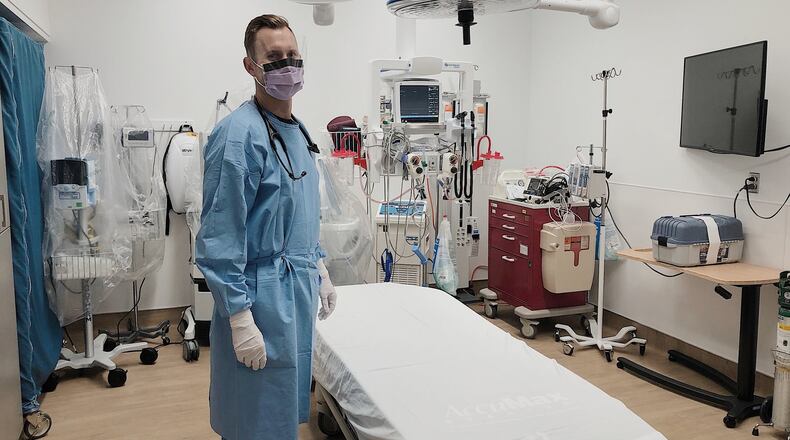» CORONAVIRUS: Complete coverage
Later that night, the Dayton Flyers, for whom the Alter grad Kohls played from 2000-04 as a walk-on turned scholarship player in his final season, won their 29th game, setting the stage for what everyone expected would be a March postseason run to remember. Everyone knows what happened next.
“It’s kind of hard to believe that was three weeks ago,” Kohls said Sunday. “It seems like it’s been a lifetime. It’s kind of been a shock for everyone.”
The end of sports, for not only the Flyers but every other team in this country, seems but a minor footnote now as the coronavirus pandemic spreads. Kohls loves Dayton basketball and travelled all the way to Maui to see the Flyers play in November. However, his mourning of the lost season has been overshadowed by what he’s dealing with every day as an emergency medicine doctor at five area hospitals, including Miami Valley Hospital. Working on the front lines of the COVID-19 crisis has challenged him in new ways.
“Over the last couple weeks, I’ve actually had some pre-shift jitters, almost like it’s a big game or something,” Kohls said, “which I haven’t felt in almost nine years since I was in my first year or two as an attending physician on my own when I hadn’t seen everything yet. I’ve even talked to some of my partners, guys who have done this for 25 years, and we’re all a little nervous at times going into the shift.”
The unknown troubles them.
‘There’s no textbook for it’
“We’re talking about a disease that didn’t exist five months ago,” Kohls said. “There’s no textbook for it. We’re all kind of leaning how to treat this, how to take care of these patients on the fly. A lot of it is just supportive care, which we’re excellent at and we have trained our entire careers to do. But there’s really no randomized trials or clinical trials telling you exactly, ‘Here’s what you should be doing for each of these patients.’”
» LOCAL SPORTS: Ohio rules golf courses can remain open
Even as number of cases of coronavirus rise in Ohio — 1,653 as of Sunday — Kohls has not seen a surge in cases at his hospitals. He has treated a number of patients who display the classic symptoms. Due to the lack of testing available, he has told many to go home, self quarantine and act as if they have it. He has admitted a couple of people who he suspects have COVID-19. They are awaiting test results.
In the meantime, Kohls said many emergency rooms across the country, except in the epicenters of the crisis, places like New York City and New Orleans, are seeing less traffic than normal because people are staying home. His brother Chris Kohls, who is an ER physician in Savannah, Ga., and his sister Jackie Kohls, a nurse in Columbia, Mo., have seen the same thing.
“It’s a little eerie and unsettling,” Kohls said. “There’s always a superstition. If you have a slow day one day, you know the next day is going to be really busy. You’re kind of feeling you’re on a beach waiting on a tsunami. The water is going out, and you’re waiting for the wave to come.”
The last three weeks have also taught Kohls more about PPE (personal protective equipment) than the previous nine years combined. Prior to this crisis, Kohls didn’t have to wear a mask every time he treated a patient with a respiratory issue. The highly-infectious nature of the coronavirus has changed that.
Ideally, Kohls would change his equipment for every patient. He said there’s a big controversy in the medical field right now about how much doctors should change their protective gear. He changes masks once or twice per shift because there aren’t enough masks to do it any more than that. He has plenty of gloves and gowns.
» ARCHDEACON: UD soccer star from Norway stranded in Dayton
Kohls also works at Miami Valley North, Miami Valley South and smaller ERs at Austin Landing and in Jamestown. He praised fellow doctor Randy Marriott for creating a split-flow triage. Sometimes even before a patient walks in the door, a nurse meets them, and if they’re having respiratory issues, they get sent to a different area of the ER, separating them from patients who are experiencing chest pain or stroke symptoms or other problems.
“It’s a completely different kind of protocol than anything we’ve ever done before,” Kohls said. “At Miami Valley Hospital, we have the ability to actually bring them in a different door, and they’re going to a completely different section of the emergency department. Some of our smaller emergency departments, you go in and there’s a certain section of the ER where we’re going to put these people.”
Hospitals are using new technology
Kohls appreciates the work Gov. Mike DeWine and Dr. Amy Acton, director of the Ohio Department of Health, have done in helping the state flatten the curve. Slowing the rise of the pandemic has given hospitals more time to prepare, allowing them to work on getting more masks and ventilators and making sure they have staff in place when the number of cases increases.
Another way Kohls has seen his hospitals adapt is by adding more telemedicine. They put iPads in rooms for patients suspected of having COVID-19. After an initial assessment in the room, they have the option of interacting with patients with FaceTime, minimizing the amount of time staff spends in the room.
» MORE COVERAGE: Springboro woman adjusts to new normal | UD Arena staff doing their part | Local restaurant adapting
The idea of taking the infection home to his wife Jennifer and kids, Katelyn, 9, and Jake, 5, is hard, Kohls said. Many doctors have started taking off scrubs in their garages as soon as they get home and putting them in a bag and then going directly to the shower, reducing the risk of spreading the disease.
Of course, Kohls said, “Ultimately, unfortunately, if we’re going to get a family member sick, it’s not going to be because we brought it home on our clothes. It’s going to be because we get the disease.”
That’s a much bigger problem than the shock of basketball ending abruptly March 12 with the cancellation of the NCAA tournament, though Kohls said that was a tough moment for him as a fan and as a former player who experienced the NCAA tournament twice.
“I really felt for the guys,” he said. “I can’t even imagine. You’re doing so well. You have all these high hopes and dreams and aspirations. The next thing you know it’s over. But from a physician’s standpoint, maybe it’s been easier for me because I understand why they did it. I think ultimately over the course of this, lives are going to be saved because of these decisions.”
The biggest fear for Kohls and many ER doctors is a surge of patients that overwhelms the hospitals and forces them to make choices about who gets a ventilator. He hopes the current measures prevent that.
“All of us in the health-care industry are very deeply appreciative of the general public participating in the social distancing,” Kohls said. “We really understand that a lot of people made pretty significant sacrifices. Unfortunately, people lost their jobs. Some people lost significant income. Kids are missing out on education. There are childcare issues. But I’m hoping by doing this we can be there for everyone who needs it.”
About the Author

